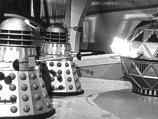 |
|
The Daleks and Mechanoids Battle it Out
|
|
 'We must face the facts - the Daleks are closing in on us.' 'We must face the facts - the Daleks are closing in on us.'
 … and they are closing in on The Doctor in a chase through both the universe and through time itself. For having created their own time machine, the Daleks are able to pursue the TARDIS from the planet of Aridius, on to the Empire State Building in 1966, on to the Marie Celeste in 1872 and even on into a haunted house within someone's nightmare. … and they are closing in on The Doctor in a chase through both the universe and through time itself. For having created their own time machine, the Daleks are able to pursue the TARDIS from the planet of Aridius, on to the Empire State Building in 1966, on to the Marie Celeste in 1872 and even on into a haunted house within someone's nightmare.
 Recognising that he must force a resolution to this desperate chase through time, the scene is set for a confrontation between the Time Lord and his most feared enemy on the jungle planet of Mechanus. Recognising that he must force a resolution to this desperate chase through time, the scene is set for a confrontation between the Time Lord and his most feared enemy on the jungle planet of Mechanus.
|
| | Source: BBC VHS Video | |
| Season: |
Two
|
| Production
Code: |
R |
| Story Number: |
16
|
| Episode Numbers: | 72 - 77 |
| Number of
Episodes: |
6 | | Percentage of Episodes Held: | 100% | | Working Titles: | "The Pursuers" |
| Production
Dates: |
April - June 1965 |
| Broadcast Started: | 22 May 1965 | | Broadcast Finished: | 26 June 1965 |
| Colour Status: |
B&W |
|
Studio: |
Ealing Television Film Studios and Riverside (Studio 1) |
|
Location: |
|
Camber Sands (East Sussex) and White City Underground Station (London). |
|
| Writer: | Terry Nation | | Director: | Richard Martin | | Producer: | Verity Lambert | | Story Editor: | Dennis Spooner | | Editor: | Norman Matthews | | Production Assistants: | Alan Miller and Colin Leslie | | Assistant Floor Manager: | Ian Strachan | | Designers: | John Wood and Raymond P Cusick | | Costume Designer: | Daphne Dare | | Make-Up Designer: | Sonia Markham | | Cameraman: | Charles Parnall | | Lighting: | Howard King | | Fights Arranged By: | Peter Diamond | | Incidental Music: | Dudley Simpson | | Special Sounds (SFX Editor): | Brian Hodgson | | Studio Sounds: | Brian Hiles and Ray Angel | | Title Sequence: | Bernard Lodge | | Title Music: | Ron Grainer and the BBC Radiophonic Workshop. Arranged by Delia Derbyshire | | Daleks Originally Created By: | Terry Nation |
| Number of
Doctors: |
1 | | The Doctor: |
|
| Number of
Companions: |
4 | | The Companions: |
|
| Additional Cast: |
|
Robert Marsden (Abraham Lincoln), Roger Hammond (Francis Bacon), Vivienne Bennett (Queen Elizabeth I), Hugh Walters (William Shakespeare), Richard Cox (Television Announcer), Peter Hawkins, David Graham (Dalek Voices), Robert Jewell, Kevin Manser, John Scott Martin, Gerald Taylor (Daleks), Jack Pitt (Mire Beast), Ian Thompson (Malsan), Hywel Bennett (Rynian), Al Raymond (Prondyn), Arne Gordon (Guide), Peter Purves (Morton Dill), Dennis Chinnery (Albert C Richardson), David Blake Kelly (Capt Benjamin Briggs), Patrick Carter (Bosun), Douglas Ditta (Willoughby), Jack Pitt (Cabin Steward), John Maxim (Frankenstein), Malcolm Rogers (Count Dracula), Roslyn de Winter (Grey Lady), Edmund Warwick (Robot Doctor Who), David Graham (Mechanoid Voice), Murphy Grumbar, Jack Pitt, John Scott Martin (Mechanoids) |
| | Setting: |
|
Planet Aridius, Empire State Building (New York City, 1966) Mary Celeste (Atlantic Ocean, 19th century), House of Horrors (Festival of Ghana, 1996), Mechanus (23rd century), London (1965) |
|
|
Villains: | Daleks and Mechanoids
|
| No. |
Episodes |
Broadcast
(UK) |
Duration |
Viewers
(Millions) |
In
Archive |
| 72 | The Executioners | 22 May 1965 | 23'25" | 10.0 | 16mm telerecording | | 73 | The Death of Time | 29 May 1965 | 23'32" | 9.5 | 16mm telerecording | | 74 | Flight Through Eternity | 05 June 1965 | 25'23" | 9.0 | 16mm telerecording | | 75 | Journey into Terror | 12 June 1965 | 23'49" | 9.5 | 16mm telerecording | | 76 | The Death of Doctor Who | 19 June 1965 | 23'27" | 9.0 | 16mm telerecording | | 77 | The Planet of Decision | 26 June 1965 | 26'29" | 9.5 | 16mm telerecording |
| Total Duration |
2 Hours 26 Minutes |
| Average Viewers
(Millions) |
9.4 |
| Doctor Who Magazine Poll (1998) | 59.87%  (Position = 122 out of 159) (Position = 122 out of 159) | | Doctor Who Magazine Poll (2009) | 60.17%  (Position = 157 out of 200) (Position = 157 out of 200) | | Doctor Who Magazine Poll (2014) | 62.74%  (Position = 175 out of 241) (Position = 175 out of 241) | | Doctor Who Magazine Poll (2023) | Position = 14 out of 29 |
 All episodes exist as 16mm telerecordings. All episodes exist as 16mm telerecordings. |
|
|
|
|